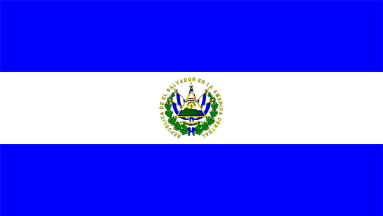 (189:335)
(189:335)  image by Željko Heimer, 7 January 2003
image by Željko Heimer, 7 January 2003National Flag and Naval Ensign

FOTW beschäftigt sich mit der Wissenschaft der Vexillologie (Flaggenkunde).
Alle auf dieser Website dargebotenen Abbildungen dienen ausschließlich der Informationsvermittlung im Sinne der Flaggenkunde.
Wir distanziert uns ausdrücklich von allen hierauf dargestellten Symbolen verfassungsfeindlicher Organisationen.
Last modified: 2021-03-13 by rob raeside
Keywords: el salvador | america | phrygian cap | volcano | sun | united states of central america |
Links: FOTW homepage |
search |
disclaimer and copyright |
write us |
mirrors
 (189:335)
(189:335)  image by Željko Heimer, 7 January 2003
image by Željko Heimer, 7 January 2003
National Flag and Naval Ensign
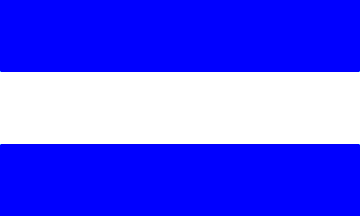 (3:5)
(3:5)  image by Željko Heimer, 7 January 2003
image by Željko Heimer, 7 January 2003
Civil Flag and alternative State Flag
Official Name: Republic of El Salvador
(República de El Salvador)
Capital: San Salvador
Flag adopted: 27
September 1972 (first adopted 1822, Reintroduced 1912)
Coat of Arms adopted: 27 December 1972
See also:
Other sites:
Similar to other Central American countries El Salvador has a blue-white-blue flag remembering the Central American federation from the middle of the 19th century. Like other countries derived from the federation it uses different variants of the flag for civil, governmental and military purposes. But here it is not so simple. There are at least three versions used:
For simplification purposes I call the first flag civil,
second government, and the third military flag. But their uses
are interwoven. According to W. Smith [smi75a], the civil flag is used
for civil and governmental purposes on land, the governmental
flag is used by the government on land and sea, by civilians on
sea and by the army on land. The military flag is used by the
government on land and the military forces on land and sea.
The blue-white-blue flag was for the last time confirmed on 27th
of September, 1972.
Željko Heimer, 29 February 1996
There is a long explanation of the flag (including biographies
of poets who wrote poems on the flag) at:
www.asamblea.gob.sv.
Jarig Bakker, 11 September 1999
It certainly is the Official Website of the Legislative
Assembly (Congress). Here is the translation of parts of the
page:
Flag - The flag page starts describing the flag and its
origins. It quotes its dimensions as 3,35 m x 1,89 m, each stripe
being 0,63 m wide, "or any other dimensions as long as the
flag keeps the same stripes and colours". It says it was
adopted by Decree of the Legislative Power (aka Congress and/or
Senate) on May 17th 1912. It is the same flag as that of the
Central American Federation, decreed by its National Constituent
Assembly 21st August 1823, whose colours were chosen by Manuel
José Arce when he was named chief of the Salvadorian (sp?)
militia which fought against Mexico 1822, remembering the colours
of the Argentine generals San Martín and Belgrano. Arce told
the idea to his wife Felipa Aranzamendi and his sister-in-law
Antonia Manuela [Aranzamendi?], and they both made the Flag of El
Salvador Province in white and sky blue silk.
The page then describes in detail how the national flag was first
raised in 1912. Later it says that merchant ships shall not bear
the Coat of Arms but the words "DIOS UNION LIBERTAD"
(God Union Freedom) in silver lettering, and military units the
Coat of Arms plus those same words on the top stripe and the
branch of service and unit number on the bottom stripe (gold
lettering for infantry and artillery, silver for cavalry). The
Government may authorise private companies, city councils or
official entities to place a special motto on the flag, as long
as it always bears the previously mentioned one as well.
Unauthorised use of the flag will be sanctioned with a 50 colones
fine.
It is compulsory to fly the flag on public buildings on national
holidays and on the anniversary of friendly nations, together
with the relevant nation's flag. It is also compulsory for both
civilians and soldiers to salute the flag. On national mourning
dates, the flag is flown at half staff with a black crape on the
top.
The page mentions poets who have composed poems and songs about
the flag of El Salvador: Carlos Bustamante, Armando Rodríguez
Portillo, Joaquín Zaldívar, José Leiva, José Luis Barrientos
and Carlos A. Imendía.
The page says that the 1912 flag replaced the one approved by
Decree of 28th April 1865,
the
even though by 1912 the number of stars on the red canton had
grown from 9 to 14 (standing for the 14 departments of the
Republic). The 1865 flag had 9 stars for the initial nine
departments (from the oldest to the most recent): San Salvador,
Sonsonate, San Vicente, San Miguel, La Paz, Santa Ana,
Chalatenango, La Libertad y Cuscatlán. Five departments were
later added (though I do not recall that El Salvador had any
territorial gains in that period).
It ends up describing how the 1865 flag was approved and first
raised, and how the BWB flag had been previously in use (apart
from 1822) by the Republic of Honduras, El Salvador and Nicaragua
(created by the Leon Pact 1849) from 1851 to 1865 and by the
Greater Central American Republic ("República Mayor de
Centro América"), which included the same three countries
(created by the Amapala Pact 1895) from 1895 to 1898.
Santiago Dotor, 15 September 1999
According to W. Smith's book in El Salvador there is:
a) simple tricolour 3:5 : civil and state flag
b) tricolour w/arms 189:335 : state flag, war flag and ensign
c) tricolour w/motto 3:5 : civil ensign, state flag and ensign,
war flag
So there are 3 designs one can use as state flag (say on
government buildings), and 2 designs can be used by army.
Željko Heimer, 9 November 1999
According to the Legislation, the situation
is such that we should probably not characterize any of these
designs as *the* civil flag, *the* state flag, or *the* war
flag. To fit FIAV categories, and based only on the law, I
come up with:
Flag with coat of arms: CS?/?S?
Flag with words: -SW[?]/???
Plain flag: CS?/???
The question marks because the law says nothing about military
installations that would distinguish them from other public
buildings and nothing about maritime use that clarifies which
design of the three is used in which cases. I assume Album
2000 is reliable on this front.
Joe McMillan, 21 August 2002
According to Album 2000 [pay00]:
- National Flag and Naval Ensign
(-SW/--W 189:335) - Blue-white-blue triband with the national
coat of arms in the middle of the white stripe. The coat of arms
I used is by Graham Bartram though at this size it is
probably not that important. I noted that the modern
representation (both Graham and Armand) do not include the
five-pointed star at the base of the circular inscription, that
is found in older images, like Flaggenbuch and National
Geographic 1917.
- Civil Ensign and Alternative State Flag
(-CW/CS- 3:5) - Blue-white-blue triband with yellow inscription
DIOS UNION LIBERTAD along the white stripe. The yellow (gold)
inscription is relatively new practice (in the case of Salvador
that means post-WWII). Previously variations with silver
inscriptions were used . I did not follow the issue further, was
it that at some point the gold vs. silver inscription designated
the level of the bearer (kind of). Is silver inscription
altogether abandoned today?
I would suspect that this flags would be used only is the
inscription is readable properly on both sides, and that if this
can't be ensured (e.g. cause of the price), one always have
possibility of using some of the other two versions. Then again,
the civil and state ensign has no variation and require the
inscription...
- Civil Flag and alternative State Flag (CS-/--- 3:5) - Simple
undefaced blue-white-blue triband.
The Album 1990 Recapitulative edition of 1995 shows one other
flag in addition, with note explaining the three variation of the
national flag:
1. National Flag and Naval Ensign. 189:335
2. Detail.
3. Alternative National Flag and Civil Ensign. 7:10 (this is an
odd ratio - I am ready to account it as an error/typo).
Željko Heimer, 7 January 2003
Adopted 1822 (not 1821!), minor modifications 1841, abandoned
1865. Reintroduced with minor modifications in 1912, slightly
modified in 1916, last legislation or confirmation 1972.
See: El Salvador - Historical
Flags (1865-1912).
Ralf Stelter, 22 February 2005
Decree 115, Law on National Symbols (D. O. No 171, Tomo No
236), 14 September 1972:
Art. 2 - [Describes the coat of arms as we have it]
Art. 3 - Article 3.- The coat of arms will be placed in all
public offices, official autonomous and semiautonomous
institutions, municipal offices, ports, airports, and seats of
diplomatic and consular missions. It may be used on all
types of movable property such as vehicles, vessels and items of
national property. It may also be used inside houses and
private institutions, except in places scandalous to morals and
public order. It may be used on the exterior of such
buildings only on occasions of national festivals or mourning or
when expressly authorized by the Interior Branch of the
Executive Power. [remainder concerns stationery, documents,
and coins]
Article 5.- The national flag is composed of two horizontal blue
stripes with a white stripe between them, [all] in a cloth
rectangle. The three stripes will have the same
dimensions.
Article 6 - There will be three classes of official national
flags: the great one [la magna], the one for use on public
buildings and offices, and the one for parades.
Article 7 - The great flag [la bandera magna] will be three
meters and 35 centimeters in length by one meter and 89
centimeters in width, on which will be paced the coat of arms
with all its accoutrements. Notwithstanding, when local
conditions and circumstances merit it, the flag may be used in
larger dimensions.
Article 8 - The great flag will be used on occasions in which the
three powers of the state take part in sessions, meetings, or
observances, or to celebrate national days.
Article 9 - The flag for use on buildings and in public offices
will be one meter long by 70 centimeters wide, but when the
circumstances of the building allows these measurements may be
increased. On the center stripe it will carry the legend
DIOS UNION LIBERTAD.
Art. 10 - [Rules for placement and hoisting of flag at public
buildings.]
Article 11 - The parade flag should measure one meter 45
centimeters long by 90 centimeters wide and will be mounted on a
cylindrical staff two meters 50 centimeters long by four
centimeters in diameter. The staff will terminate in a
golden-colored lance in the form of a rhombus, edged on the sides
and on the point, and of maximum thickness along the center line
that joins the angles. At the join of the lance with the
staff two ribbons of two meters in length will be affixed, one
white and the other blue, each six centimeters wide. On the
white ribbon will be inscribed the name of the establishment and
on the blue its location in gold letters. The white fringe
of the parade flag will carry the inscription in gold letters
DIOS UNION LIBERTAD.
Article 12.- Official delegations named by the government to
represent the country abroad, which have to use a flag for the
purposes of their mission, will use the flag for public offices
and buildings with the coat of arms and all its
accoutrements.
Article 13 - The national flag in reduced dimensions with the
shield or with the legend or simply the colors may be used on all
state property where appropriate. The same applies to
private properties for the purpose of civic celebrations.
Article 14. - National ships or those of Salvadoran registration
will use the national flag in conformance with treaties,
conventions, or special dispensations.
Joe McMillan, 21 August 2002
Well, having lived and traveled extensively and often in El
Salvador, I can tell you what I have observed and know about the
usage of this flags:
1. All the government buildings, inside government offices, the
presidential house (Casa Presidencial), the flag in the
president's office or other officials, National Palace, border
crossings, airport, ports, embassies, consulates, municipalities,
boats, airplanes, etc.; also the five huge (18 feet x 30) feet
flags that are located one at flag plaza (Plaza de la bandera)
and the other 4 at the four cardinal points of entrance into the
capital city, all use the flag with the national emblem usually
in the 3x5 ratio.
2. All army, air force, navy, military schools, military
hospitals, navy posts at the ports, etc., fly outside the flag
with the inscription (DIOS UNION LIBERTAD) in a yellow gold color
and such flags have a 1x3 ratio.
The battalions will have the flag with the emblem with Dios Union
Libertad in gold on the upper blue stripe and the name of the
battalion class and number in gold on the lower blue stripe for
artillery and infantry and in silver for cavalry.
Merchant boats have the letters in silver or blue.
3. The plain flag without the emblem can be seen sometimes at
schools, houses,, etc.
Fred Drews, 22 August 2002
I see El Salvador flags on a regular basis. The main
highway through the part of northern Virginia where I live is
plentifully supplied with Salvadorean restaurants serving the
immigrant community, almost all of which have Salvadoran flags
displayed, either flying outside or hanging on the wall
inside. And, as I said at first, they all have the
emblem. So, at least de facto, this as well as the plain
one would seem to be the civil flag - and there's nothing in the
law to preclude that, as far as I can tell.
Joe McMillan, 22 August 2002
However, one should consider that they use the flag with the
emblem so nobody will misidentify then as Argentine or other
B-W-B flags.
Dov Gutterman, 22 August 2002
That would not be easy to distinguish from 189x335 (ca.
3:5.3). Though, I could imagine that manufacturers
"simplify" it to 3:5.
I guess that today, when flags with emblem and inscriptions are
more easily acquired, the plain flag would be less and less used.
Especialy, since it seems there is no legal hindrance in using
the other two.
Željko Heimer, 22 August 2002
They did ask for flags in the following dimensions 90 cm x
150 cm when I supplied quite a few satin flags with embroidered
coat of arms to some of the government offices, entities and
ministries for official acts and offices of dignitaries.
Concering the ratio of 1:3. When I offered to sell them the flags
they told me that they are manufactured by the army to be flown
on their buildings, hospital, schools etc. and that is the ratio,
they all are manufactured. I wonder if it this has to do with the
letters, because they expand almost the whole extension of the
white stripe. The letter are quite wide and tall.
Fred Drews, 23 August 2002
The protocol manual for the
London 2012 Olympics
(Flags and Anthems Manual
London 2012 [loc12]) provides recommendations
for national flag designs. Each
NOC
was sent an image of the flag, including the
PMS shades, for their approval by LOCOG. Once this was obtained, LOCOG produced
a 60 x 90 cm version of the flag for further approval. So, while these specs may
not be the official, government, version of each flag, they are certainly what
the NOC
believed the flag to be.
For El Salvador: PMS 300 blue, 102 yellow, 032 red, 348 green and black. The
vertical flag is simply the horizontal version turned 90 degrees clockwise.
Ian Sumner, 10 October 2012
I located a flag variant at a photo
at
story.news.yahoo.com.
The item is described there as " Salvadoran doctors march
through the principal streets of San Salvador, El Salvador,
Wednesday, Oct. 16, 2002. Thousands of doctors marched through
the city to protest the privatization of health care. ( AP
Photo/Victor Ruiz Caballero)"
John C. Evosevic, 16 October 2002
This flag was created by a company that makes flags, so they
could be used for soccer games in order not to get confused with
flags of Honduras.
Fred Drews, 17 October 2002
While traveling in San Salvador this year, the new mayor of the city has
placed flags of the city of San Salvador all over the city next to the flag of
El Salvador, I am enclosing a
picture
of the flags flying on an overpass. Interesting also is that the flag with the
inscription on it is also flown all over the city instead of the flag with the
coat of arms (which is also seen). I am enclosing a
picture
of the flag, flying at the Plaza de la Bandera.
Fred Drews, 05 August 2011

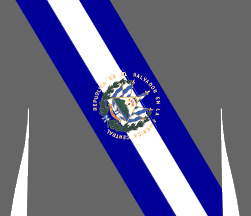 images by Fred Drews and Francisco Gregoric, 18
July 2007
images by Fred Drews and Francisco Gregoric, 18
July 2007
Presidential sash from the inauguration of president Araujo in 1911

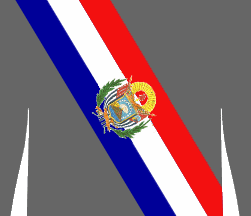 images by Fred Drews and Francisco Gregoric, 30
July 2008
images by Fred Drews and Francisco Gregoric, 30
July 2008
Presidential sash from the inauguration of president Araujo in
1911 with the old flag of El Salvador.
Fred Drews, 30 July 2008
Presidential sash of president Gerardo Barrios 1858

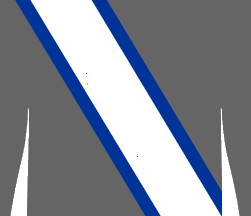 images by Fred Drews and Francisco Gregoric, 12
August 2009
images by Fred Drews and Francisco Gregoric, 12
August 2009
 image contributed by Fred Drews, 12 August 2008
image contributed by Fred Drews, 12 August 2008
Hosted by: Fanshop-Online.de und Handy-Shop.de
Tipp: Apple iPhone 12 im Shop